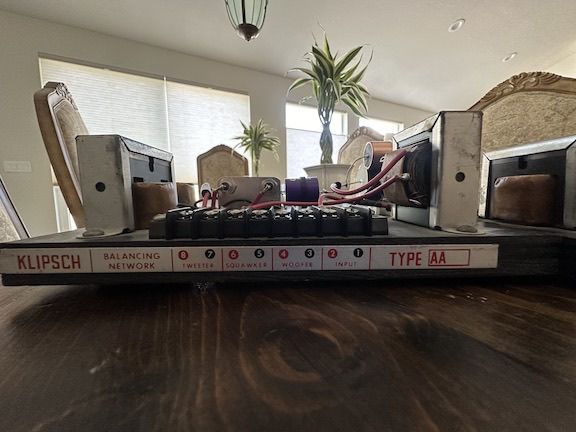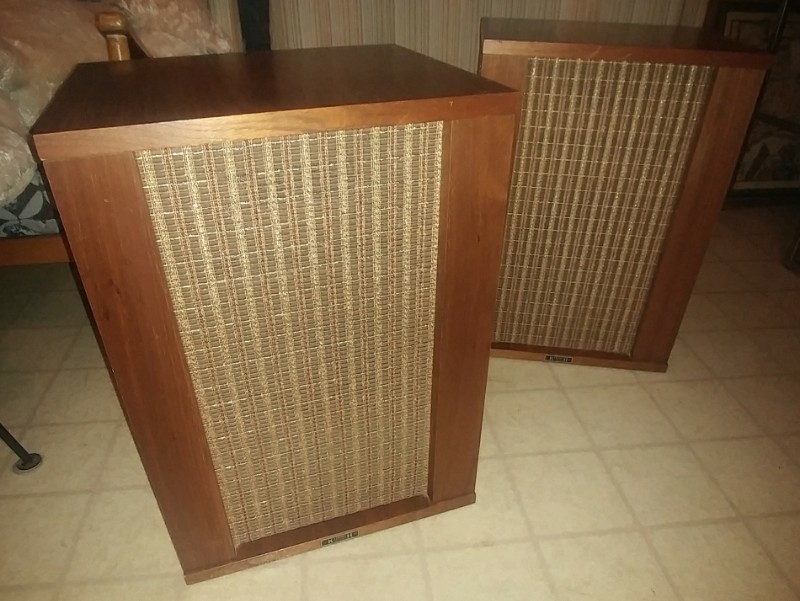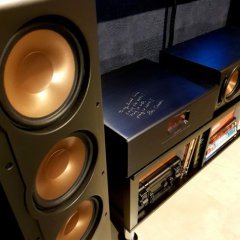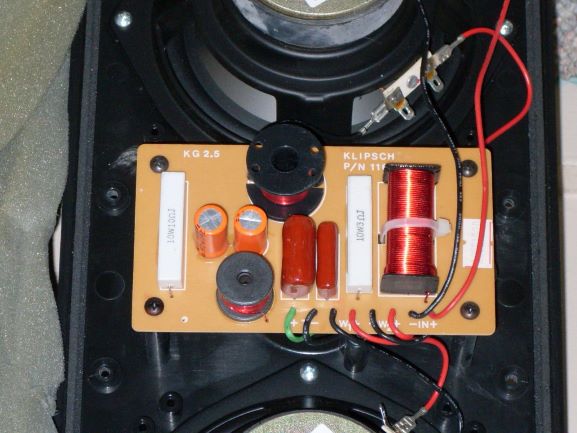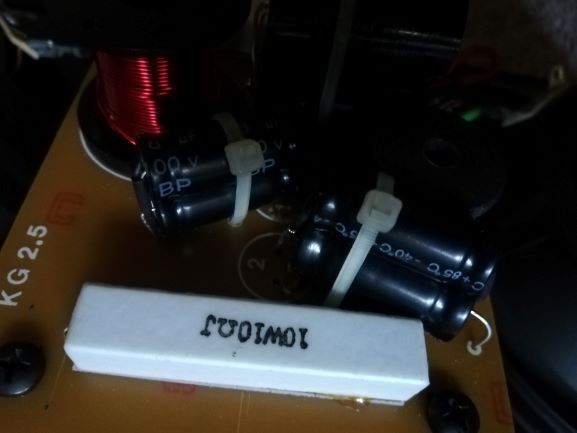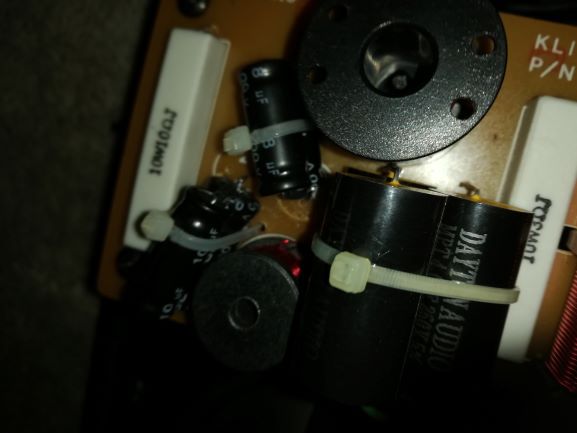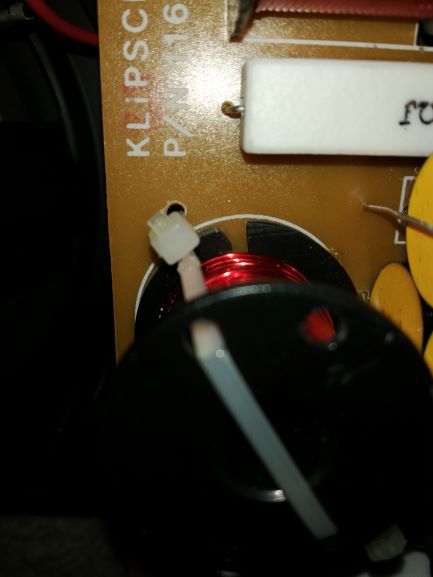Search the Community
Showing results for tags 'crossover'.
-
AA Crossovers for Klipschorn, La Scala, Belle - Upgraded with Clarity Caps and Audio Note copper foil These are super lively sounding, excellent extension $400 including CONUS shipping PayPal (verified), Venmo, Money Order, cash in person (Salt Lake City region)
-
- klipsch
- klipschorn
-
(and 3 more)
Tagged with:
-
Ok so I've been dealing with this noise from my stereo speakers for the past year and a half or so and I know i found one of the issues its in my crossover. It's a pioneer CD-635 that I picked up from a friend and a friend of mine soldered the wires on the harness for me but must not have got it quite right because when I was rewiring some things earlier I touched the ground wire at the harness and it cut off and on so there is a short somewhere. My question is on the inside where the harness plugs in it's labeled...gnd...acc...b in....b out.. not sure I know what b in and b out mean exactly. Thinking battery but Ive not seen that before I don't think(I'm by no means a professional) and what would the acc be? I know it stands for accessory so would that be a remote? This could explain a lot of my issues. Help please and sorry I'm an idiot
-
II have recently acquired a pair of consecutively numbered (164 & 165) Klipsch Model H speakers. I have found some information on them, but had more questions. It seems there were 18 of the 8" versions of these, but how many where made of the 12" in this style? Is there more information about various drivers in these? Based on looking at the screws before opening, they don't seem to have been opened before I took the back off of one, but the 12" driver is a Cletron Cathedral. The nuts holding the speakers all have the same amount of white corrosion too. Did this brand of woofer show up in other early Klipsch speakers? Lastly, I will need to change the capacitors. One has a 2uf with two taps and wires going to each of those. The other is 4uf with one tap where two wire attach, and another wire going to the metal can of the capacitor. I'm curious how to wire modern caps in place of these, I have an idea, but would like to hear other thoughts to be sure. Mostly I wanted to share photos since there aren't many of this model that I can find, and I didn't see any photos of the inside. These are extremely clean all around, excellent condition of wood and cloth.
- 9 replies
-
- 3
-

-
- klipsch model h
- crossover
-
(and 1 more)
Tagged with:
-
Hi there! I recently upgraded my Klipsch Chorus ii with a nice pair of Khorn! I'm the third owner, the original owner upgraded the crossovers and tweeters with B&C tweeters and A crossovers. I was under the impression Khorns should use ak-3 crossovers. Am I missing something? Should I upgrade to AK-3 crossovers? Not sure if I'm getting the best of my speakers with A crossovers. Any advice will be greatly appreciated ! Thanks in advance. Ed
- 13 replies
-
- khorns
- klipschorn
-
(and 4 more)
Tagged with:
-
Klipsch Forte III Pair of Midrange drivers Pair of Tweeter Pair of Crossover network. Price $250 Carefully remove from Forte III during the upgrade to IVs They were excellent shape and excellent functioning. Local Pick up 91042 Tujunga
-
Hello, I was wondering if someone could let me know what's the best crossover setting for my setup Speaker Setup: 5.1.2 Front: RP-280FA Floorstanding Center: RP-504C Surround: RP-500M Bookshelf Speaker Subwoofer: R-112SW Projector: Optoma CinemaX P2 Receiver: Onkyo TX-NR6100 Thanks!
-
I’ve searched through the forum and not found a satisfying answer, so I’m just going to ask what may be a silly question: Can I use an axial capacitor in place of a radial and, more importantly (or more confounding to me), how can the axial be mounted sufficiently? This question is in regards to a pair of KG 1.5 speakers I recently acquired. The sound was off between them so I opened them up to find one blown woofer. While the crossover was out I desoldered a 25uf cap and checked it - it read 28.5, so out of spec. Klipsch still has the woofers (yay!) so I ordered them. I’m having trouble finding a decent radial 25uf capacitor (and a 20uf) to replace the old ones. Axial’s are available though. Any insight greatly appreciated!
-
Hey everyone , Can you please help me with the crossover settings of speakers and subwoofer because I don't like the way my speakers and subwoofer sound . I have R-121sw sub but even though gain is really low the bass doesn't sound how I imagined it is really powerful and boomy . Even my Jbl charger 5 portable speaker has deeper and cool bass I have read a lot of documents about room acoustics and crossover but cant seem to find the sound I like . Thanks already I have Sony Str-DN1080 amplifier , Subwoofer : R-121SW Center : R-52C Front/surround : R-41M Atmos : Sony SS-CSE
-
Hello community, can anyone steer me in the correct direction to buying an RF-83 crossover. Thank you, Carlos
-
I'm selling my barely used B2 crossovers by Aletheia Audio. I installed them mid August (sounded wonderful) and then bought khorns 3 weeks later. Maybe 20 hours on them max. Built with Jensen, Dayton, and paper in oil. See pics. There are holes in the mounting board as I did install them. Asking $585 plus shipping (net to me if using PayPal).
-
I am trying to recap a pair of RF-3s using some old info I have found on the site. I have attached the schematic for reference. I am unable to find the 4.5uF caps from Dayton Audio. All I see are 4.3uF and 4.7uf. a) what would the difference be running one of these two? b) does anyone have a recommendation besides Dayton Audio that would have a 4.5uF cap available? My apologies if I have posted this in the wrong forum. If so, please let me know the best place to pose this question. Thank you. Klipsch RF-3 crossover schematics.pdf
-
I have a larger (33x15x9) room and a new set of Klipsch RP-600m speakers. I also have a pair of 15" downward-firing subs. My crossover (JL Audio CR-1) is capable of discreet R/L stereo bass management. At what frequency should this pair of satellites be crossed over to the subs for stereo audio use only? I've had audio amigos advise me that I should set the crossover as closely as possible to the -3dB roll-off point of the satellites, but as I see it, this has numerous potential disadvantages: 1. The acoustic roll-off of the speakers will be added to that of the upstream electronic crossover, causing asymmetrical crossover rates between the satellites and the subs. 2. The intermodulation distortion of the satellites will be increased because of the higher woofer excursion on the satellites. 3. The single 6.5" woofers of the satellites will be stressed at high volumes in my room. I've (conversely) also had other audio amigos recommending to me that since I do have two subs, and because those subs will (initially) be located as closely as possible to the satellites, that I set the crossover to as high a frequency as possible (150 Hz. with the JL). As I see it, this does have some advantages, but also some disadvantages: On the plus side: 1. The intermodulation distortion of the satellites should be minimized because the longer excursions required for lower bass will be handled by the subs (whose larger cone area will minimize distortion for the same volume). 2. The amount of current required to run the satellites will be greatly reduced allowing the use of much lower wattage tube amplifiers if desired. 3. By judicious use of the phase knob on the sub's plate amps, I can move the subs more independently of the satellite locations. But on the minus side: 1. Having a higher crossover frequency may allow the transition from satellites to subs to become more audible. 2. At higher frequencies, acoustic localization of the subs may become more likely. 3. The downward-firing design of the subs may muffle the higher frequencies. The specific subs being used are Powersound Audio S1510DF models, a sealed-box design that has worked well in my room before. I plan to use the JL crossover with 24dB / octave slopes, rather than the more ubiquitous 12. So noting that movie soundtrack use is NOT a priority for this system, where should the crossover point be set? Thanks in advance for your help - Boomzilla
-
Hello Klipsch audio community, this is my first post here - actually I made an account specifically to ask about this topic, which has been mystifying me. I pick up multimedia speakers at my local thrift stores quite frequently, and Klipsch ProMedia speakers are a common sight (people seem to get rid of them because the pots on the control pods go bad). Usually I end up with a large number of ProMedia satellites with an odd mixture of subs and control pods, so I mix and match until I end up with complete systems, which isn't very difficult. I quickly noticed, however, that there seem to be a noticeable difference in tonality between some of the satellites - and the differences are often split between satellites from entire sets (for example, the 4 satellites I picked up from a ProMedia 4.1 set sounds noticeably brighter and louder than the satellites I found from an old ProMedia 2.1 set from the early 2000's). I know that companies often do iterative updates to their products' internal components, and I wanted a way to be able to identify the different satellite revision(s) so I can match them properly when I put together systems. After finding absolutely no cosmetic differences in the satellites' exterior, I decided to open them up... and what I discovered was a bit, well, surprising. In the photo attached below, you can see two satellites right next to each other. They look identical on the outside. Opening the first satellite, one can see a circuit board to handle the crossover. It appears to contain a capacitor, a resistor, and an inductor, pretty standard affairs for a crossover circuitry. Opening the second satellite, one finds that the entire circuit board to be missing. In its place is a single bipolar capacitor, manufactured by Bennic. My guess is that the first satellite is in fact the older version, because the circuit board is screwed onto two plastic mounts that, in the second satellite, are still present but unused. When I first started researching the topic, I came across an old discussion about the ProMedia 4.1, which was stated to have "improved crossover frequencies". Coincidentally, the first time I noticed the tonal differences in the satellites, it were ones from a ProMedia 4.1 system (containing the second version, with the single capacitor). I currently have 18 ProMedia satellite speakers on hand. I have opened up every single one, and found that 12 of them were of the second iteration, while only 6 were of the original configuration. So the "new" version has been around for a long while. I am not an electrical engineer, but a quick read on how crossover circuits work showed that inductors act as low pass filters (becoming more reactive as frequency increases), while capacitors act as high pass filters. The fact that the inductor and its companion resistor are absent in the "new" revision of the satellites likely means that the full-range driver is receiving the full spectrum of audio signal (minus whatever LFE that's sent to the subwoofer by the filter in the amp module), including everything that's meant for the tweeter. This may explain why these satellites sound somewhat brighter (I am assuming the full-range driver can reproduce at least some of the treble frequencies), as well as louder (less components in the signal path, less resistance). Now.. I know audio companies spend a lot of money on R&D, so I am not accusing Klipsch of cutting corners or anything like that. My main question is... which satellite version actually perform objectively better? I do not have any instruments to measure frequency responses, but may be someone can look into this? And a question for Klipsch: What is the reason behind this internal change? Do the new satellites still perform up to THX specifications?
-
I have a pair of 1984 first gen KG4's (even though they are listed as starting production in 1985, the labels on the back say 1984). I never liked these speakers! They sounded very harsh and edgy, yet yielded a very good sound stage, but they just fatigued my ears. Five years ago I read on one of the Klipsch forums about Bob Crites having designed and contracted a fabricator to make a titanium replacement for the phenolic horn drivers showing scope readings of a virtually, very flat response on supposedly sounding much smoother and liquid. For about $50 I ordered the pair and swapped them in and everything that people were saying was true. Very smooth, open, and airy, but without the jagged harshness. It was like listening to a completely different speaker -- one I fell in love with and became my main speakers. A couple of weeks ago, I read about the capacitors loosing their life around the 20 year mark and it hit me that the caps in my 1984 KG4's are now 31 years old. When back to Bob Crites' website and for $100 I could send him the original networks for a cap replacement, or for $200 I could receive new networks with all upgraded materials including new chokes, etc. -- I opted for the latter. I ended up removing all of the old “stacked-up” networks of this first gen that had everything glued up in a pile on the back of the input panel – turns out that the choke and transformer? (coiled bobbin) just popped off the plastic input back panel by prying a flat head underneath them and giving a little twist, removed the 3 screws, popped off the one cap that was glued, and cut the wires to the terminals. Then new network board fits on the wood floor of the bottom of the cabinet attached with velcro. After I finished wiring the first cab, I decided to do an A/B comparison between your network and the original 31 year old network. I conducted a very good test condition by putting on a mono LP, The Kingston Trio, and threw the balance knob Left/Right to compare them back and forth… let me tell you something, it was a dramatic difference! The old network sounded like the banjo was being played underneath a quilt. So, even though the speaker cab with the new network sounded brighter, and more open and airy, I would say it wasn’t adding anything, but simply allowing what was naturally in the recording to come through, whereas, the 31 year old network was not allowing all the highs to pass through to the horn. When I listened to the speaker cab that still had the original network, it was a kin to turning the treble control about 3/4’s the way down. As far as the bass, I’m not sure if it’s in my head or not, but it sounded a little tighter – just as strong as before, but with a little less resonance. Once again, Bob Crites has amazed me with his quality designs and engineering. I now have the ultimate KG4’s with Crites’ titanium horn drivers and upgraded, new networks! BTW, they are works of art just to look at (see before and after pics). And because the new networks are mounted on new cedar boards, they smell good too! I’ll never have to worry about moths in my speaker cabs I'm sure all of you know about Bob's Klipsch upgrades and maintenance services, but just in case you don't: www.critesspeakers.com Original 1984 network: New Bob Crites network:
-
Drivers: K22, K53 & K77------->K28, K53Ti, K107Ti; CWIII Xover - K53Ti ,K107Ti Level reduced 3dB by RME DAC Setup: Internet Stations | | Router 2010 Mac Mini | Ripped CDs, Downloads | MinimServer V2-----------DLNA/UPNP--LAN--Yamaha WXC-50---RME ADI FS-2----NAD C160--------|---B&K ST2140----H III MinimStreamer / Yamaha CX-2--|---------------R115SW Sub | Pioneer PLX-1000 | Denon DL-110/DL-301/ | AT VM540ML-------------------------------------------------------------------------------------------------------------
- 8 replies
-
- 1
-

-
- rme
- b&k st2140
- (and 11 more)
-
Crossover setting for receivers for klipsch rp speakers
Markwwwwhiuii posted a topic in Home Theater
What are the best crossover settings for a long room two subs (one deep bass and one non deep base) up for the following speakers: RP 6000F (my front left and right) RP 42S (my right and left surrounds) RP 504 C (my center) -

heresey iii Convert Cornwall III Xover to Hersey III
radiogram posted a topic in Technical/Restorations
Hello, hope everyone is staying safe and healthy. I need to convert my CW3 Crossover network to H3. The CW3 kit was originally bought to experiment with my cornscala. Couple of years ago I upgraded my Hersey 1.5 to H3, with CW3 Xover and K28, K53Ti and K107 Tweeters. And for a while I used a Autoformer to lower the mid and tweeter section by 3db. Now instead, I am using a RME DAC's EQ to lower mid and tweeter by 3db. But this only solves digital sources. I would instead like to make the network a proper H3 network. I checked with Michael Crites, he does not have the schematics of either. If any of you have schematics of CW3 and H3 and since both the H3 and CW3 are no longer in current production, could you share them ? BTW, I am in the process of building a top section cabinet (trapezoid) as I like the higher soundstage with the mid and tweeter on top of the cabinet. Thanks & Cheers -
Greetings, Long time Klipsch owner but new to forum.. just picked up a very lovely sounding RC-7, not sure why I waited so long., now being used as my center channel. Since Crites passed recently,, my condolences to his family and friends, .. and it looks like DeanG is retired from retirement,, who is reputable to take on a crossover rebuild/refresh? While my new used speaker is working as expected, it is original and stock so I am sure at a minimum the caps need updating.. after 12-15 years, maybe more? Thanks, Mike
-
I have three pairs of RP-140SA speakers in my 7.1.2 set up and I am having trouble with the crossover setting for the RP-140SA. According to the spec sheet, the frequency response for the speaker, "conforms to Dolby Atmos Specification." Apparently this is some secret thing because I can't find it anywhere, at least for home theaters. My pre/pro does the auto-eq routine but like most, it varies and sometimes the RP-140SA crossovers are calculated at 40Hz (yeah right!) and sometimes they are 120Hz + or - 40Hz. I don't know why it's some secretive thing, but it would be nice to know what the bottom range is so I don't over-drive them. Does anyone know what the low end of the frequency response is? I'm sorry to sound like this, but I just find it frustrating that this basic number isn't published on Klipsch's or Dolby's site.
- 27 replies
-
- 1
-

-
- atmos
- frequency response
-
(and 3 more)
Tagged with:
-
Hi all! This has probably been answered somewhere before, but I'm not finding it. I'm looking to tri-amp a pair of 1988 Heresy II's I just picked up, and to do the Heresy II->Heresy III conversion on them, and then tri-amp them again. Does anyone have the Heresy II and Heresy III crossover specs? 1) What are the crossover frequencies and slopes? 2) What's the attenuation (padding) of the different drivers? 3) Are any of the drivers polarity inverted? These would be different for the Heresy II, and III -- and I'm looking for both sets of data for before and after the conversion. Thank you!
-
(Please be patient as I'm visually impaired. If you point to any information it would be helpful to provide clear links and description of what I'm looking at so I can follow. Thanks.) I bought a pair of Forte II used and was told they have both the Citrix crossover and titanium tweeter according to the seller. That is the extent of my knowledge on them. I can hear they are probably working soundly during two states, blasting loudly or when I crank the treble down and max out the bass on my amps. This leads me to believe they are mechanically sound, but possibly misconfigured. I don't think they could intentionally be this bright, they loose all boogie and become treble cannons at regular volumes. They appear to be functioning soundly, but they don't seem to register much on the low end except in these two circumstances. I've done lot of failed searches to try to understand these crossovers but that's tricky with my visual impairment. Can anyone tell me if there is a straight forward way of adjusting these crossovers with pins to redistribute some of the power to the low end? I know some replacement crossovers you can just change some terminals. I gathered the former owner had a high frequency hearing loss and I'm no longer in touch with him, but I wondered if he had them configured bright without knowing it, he also said he played them pretty loud which seems to masks the problem. Note that I am getting the same results off a variety of amps with various power levels ranging from 20wpc tube monoblocks to 55wpc RMS NAD receivers. Any thoughts are appreciated. Thanks (a few photos post wood restoration and new grills I made. In the end I manged to clean up the original very well too. So I have to sets now.)
-
UPDATE (4/3/20): Still hope everyone is doing well and finding ways not to succumb to "cabin fever" 😵 Since I did a tweeter upgrade recently, it gave me a chance to take another pic of the x-over board showing how I fixed the loose coil using tie wraps. I have added that to the collection of photos below....Cheers.... ------------------------------------------------------------------------------------------------------------------------------------------------------ Hope everyone is hunkering down and hanging in there with all this coronavirus stuff going on. Be smart and stay healthy!!! I finally got around to updating my 20+ yr. old KG2.5s. I opened the spkrs. to verify cap values and found they were KG2.5s, not KG2.2s as I had come to believe for some reason (see TL;DR below...it was a definite "D'oh!" moment). Anyway, now that I had verified parts, I ordered them and they arrived a few days later. I set aside some time to do the upgrades. I planned to do 1 spkr. at a time since the new caps would be combinations to equal the original values AND some were axial (leads on either end) instead of radial (both leads on same end). This also meant drilling some new holes and figuring out how to secure the now dual-cap configs. I prob'ly could have found actual values but my research into that meant buying more (in some cases, much, much more) expensive upgraded caps (Mundorf, Solen, etc.) and spending nearly 1/2 (or more) of the price of the spkrs. Just didn't think it prudent for these spkrs. Ended up with Dayton caps for the tweeter circuit and Parts Express-branded caps for the electrolytics. TL;DR - Not remembering my spkr models - When I started the upgrade I opened 1 spkr. (configuration is a heavy plastic front panel with both woofers(?), the tweeter and the x-over PCB mounted to it which is then mounted into the front of the box with 8 wood screws) and removed the x-over board. That's when I noticed a couple of things wrt the model. I saw KG2.5 printed on the PCB (possible explanation for cap values I didn't expect), and my first thought was maybe this was a mfg. error and why I bought them (KG2.2) at a fairly good price way back when. Then I looked at the part number printed on the woofer (and I use that term loosely). It was not the one supposedly used for the KG2.2s. So, out to the garage I ran to find the original box and, sure enuf, it said KG2.5. Then I realized I should look at the back of the spkrs. Once again, it was confirmed they were KG2.5s. My guess is my confusion came from the fact that I had collected a fair amt of KG2.2 tech docs and found very little for the KG2.5s. Somewhere along the way my brain decided to "remember" the spkrs were KG2.2s. Go figure.... Performing the mods/upgrades - Doing the actual mods was fairly straight forward but required some adaptations for the new caps. Original caps in the woofer circuit were unbranded radial electrolytic NPOs: 25 uF and 18 uF both @ 100V and 10% tolerance. I replaced them with axial (100V, 10%) 10 uF + 15 uF for the 25 uF, and 10 uF + 8 uF for the 18 uF cap. Pretty much a swap except for double the parts and axial vs. radial. In the tweeter circuit were, what I believe to be, mylar caps (usually fairly stable) at 8 uF and 4 uF, 100V. No idea of the tolerance. I replaced those using 4 uF caps. I simply used one 4 uF cap for the 4 uF replacement (duh! , and paralleled two 4 uF caps to replace the 8 uF. The new caps are 250V (only voltage available and a nice margin anyway) @ 5% (I would expect an improvement here over the old ones, tho I have no idea). Both old and new caps are axial, with the new ones a bit longer. Both sets of caps required new holes to be drilled to solder in the leads. I initially considered using a non-corrosive adhesive, but opted for tie wraps instead. Thru-holes were drilled in the PCB to provide mounting for the tie wraps. Given the caps were now double stacked (and because of the limited space available due to the new the 4 uF and "8 uF" caps grouped into a 3-cap arrangement, so to speak, having to fit into a smaller 2-cap space), I felt the tie wraps would offer better security and stability. Two of the original coils/inductors were constructed on plastic bobbins with a plastic insert pin (and some glue) used to hold the coils to the PCB. One of them came loose somewhere along the way and I was able to use tie wraps, as well. to resecure it to the PCB. I drilled holes in the PCB for this and used the holes already formed in the bobbins as secure mounting points (See last pic). Results of the upgrade - I've been using the upgraded spkrs for a couple of weeks at this point and I have to say I notice a better clarity on the mids and upper range. I sense there is a bit of improvement (maybe more of a restoration) for the low end, but my ears aren't sensitive enuf to really tell. Besides, I have a Klipsch 10", 150W subwoofer to take care of that so I set the receiver LFE crossover to be a bit higher (80Hz vs. 50Hz) to take a bit of the stress off the "woofers" I also detect better sonics out of the spkrs and restored clarity in the "voices" of instruments. Overall, I'm very happy. Total cost was ~$25 and a couple of hours of my time (Tie wraps were "free" cuz I had them in my parts bin So, enuf words. Time for pics. This first pic is the original x-over PCB before I swapped out caps. The 2 orange upright caps on the left side of the board are the 25 uF (left) and 18 uF (right). The 2 burnt orange caps in the center are the 8 uF (left) and 4 uF (right). You can also see how everything(!) is mounted to the front panel. Tweeter is underneath the x-over board. 2nd pic shows the completed upgrade and x-over reinstalled. Note the new mounting holes drilled to accommodate the larger, axial electrolytic caps. Not as obvious are the new holes drilled to accommodate the slightly longer tweeter caps. Pic 3 shows the tie wraps used for the double-stacked electrolytics and how they were oriented to make them fit. This pic shows tie wraps and new lead holes (~1/4" past the old holes) for the 8 uF (left in the group) and 4 uF ("nestled" in on the right) caps. Note that all 3 caps are tied in a group. Here's a pic of my fix for the loose coil. You can see the hole (one on the other side, as well, but out of view) I drilled for the tie wraps.
-
Hello all! I am new to the forum. I love my Belle Klipsch, and am the original owner. Read a post about the undesirable AB crossovers. Should I consider changing them out? Would there be a noticeable difference, improvement? Thank you for your input.
-
Hi and thanks for reading, I have a pair of La Scalas with the Type AL crossover, as pictured. It seems to be pretty hard to find a circuit diagram for this network, including from the thread between Bob Crites and ALK. There are no pictures I can find online and from the few discussions I have read, the general advice is that rather than re-cap it, this network should be replaced with something else - Both Crites and ALK have solutions, but both run into several hundred $AUD with postage and I don't have that sort of budget atm. La Scala LSBR S/N 8504510 K55-M squawker K-77M tweeter In terms of capacitors on the crossover, these are the markings on each part: 3x 2uF [+- 5%] 180 VAC - black rectangular block type 2x 8uF [+- 5%] 250 VAC - black rectangular block type 1x 30uF 250 VAC "CDE Soggy Foil Protected" 60 Hz - large canister type There is also a resistor marked "5 [Ohm] 10%" - white packaged type. My questions: Is it indeed not worth (in terms of financial outlay) replacing these parts with new components of the same values? What capacitor types are these and what would be suitable replacements (as I am not familiar with the respective uses of the various capacitor package / build types)? What would be the best bang for buck, if I had to choose between parts to replace - treble, mid or bass? I assume top end? My understanding is that there would be no benefit updating any of the inductors or transformers. Is this correct? Are there any other alternatives apart from Crites / ALK ? I would also consider DIY if I had a solid schematic and wiring guide to follow. I am spurred on to try the re-cap after some significant success replacing the caps on some 1975 Mordaunt Short speakers this week, dramatically uplifting performance! Any advice, experiences or general comments would be most appreciated. Anyone locally (in Australia anyway) done this before? Thanks! IWS



